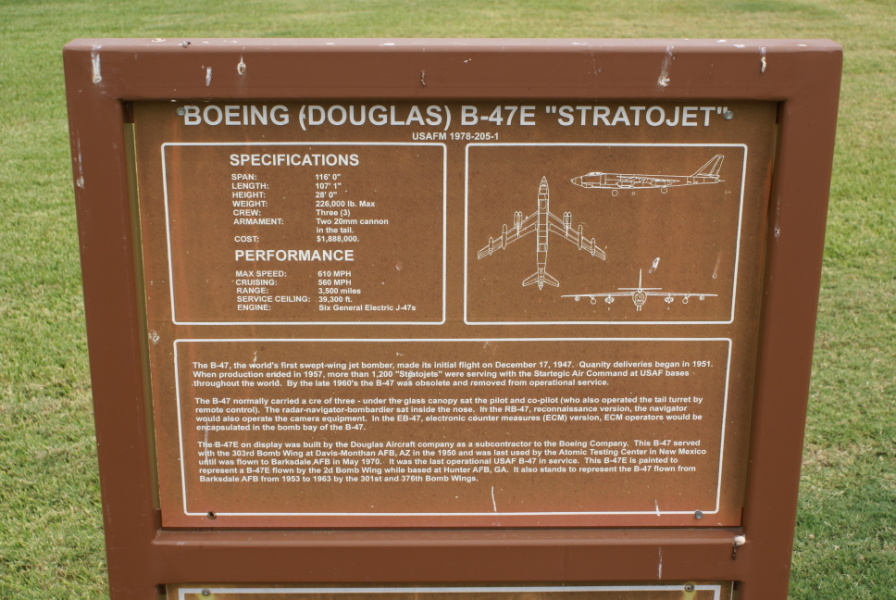| Prev |
heroicrelics.org Barksdale Global Power Museum (Formerly the 8th Air Force Museum) Site Index B-47E Gallery |
Next |
dsc51532.jpg
The sign accompanying the B-47. It reads
Boeing (Douglas) B-47E "Stratojet"
USAFM 1978-205-1
Specifications Span: 116' 0" Length: 107' 1" Height: 28' 0" Weight: 226,000 lb. Max Crew: Three (3) Armament: Two 20mm cannon in the tail. Cost: $1,888,000 Performance Max Speed: 610 mph Cruising: 560 mph Range: 3,500 miles Service Ceiling: 39,300 ft Engine: Six General Electric J47s The B-47, the world's first swept-wing jet bomber, made its initial flight on December 17, 1947. Quantity deliveries began in 1951. When production ended in 1957, more than 1,200 "Stratojets" were serving with the Strategic Air Command at USAF bases throughout the world. By the late 1960s the B-47 was obsolete and removed from operational service.
The B-47 normally carried a crew of three - under the glass canopy sat the pilot and co-pilot (who also operated the tail turret by remote control). The radar-navigator-bombardier sat inside the nose. In the RB-47, reconnaissance version, the navigator would also operate the camera equipment. In the EB-47, electronic counter measures (ECM) version, ECM operators would be encapsulated in the bomb bay of the B-47.
The B-47E on display was built by the Douglas Aircraft company as a subcontractor to the Boeing Company. This B-47 served with the 303rd Bomb Wing at Davis-Monthan AFB, AZ in the 1950s and was last used by the Atomic Testing Center in New Mexico until it was flown to Barksdale AFB in May 1970. It was the last operational USAF B-47 in service. This B-47E is painted to represent a B-47E flown by the 2d Bomb Wing while based at Hunter AFB, GA. It also stands to represent the B-47 flown from Barksdale AFB from 1952 to 1963 by the 301st and 376th Bomb Wings.

| Time picture taken | Tue Aug 5 13:55:38 2008 |
| Location picture taken | Museum Grounds Southwest of Lindeberg Rd. Barksdale Global Power Museum (formerly the 8th Air Force Museum) Barksdale AFB, Louisiana |
| Prev | B-47E Gallery | Next |